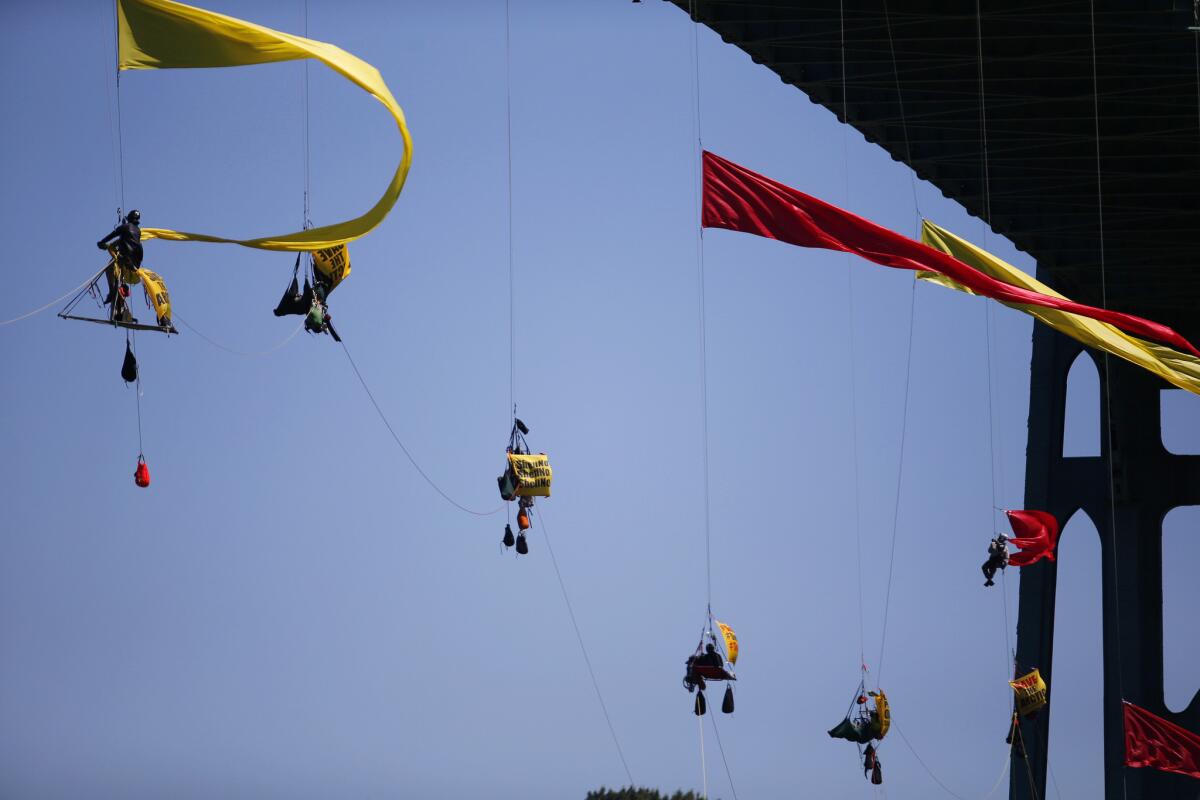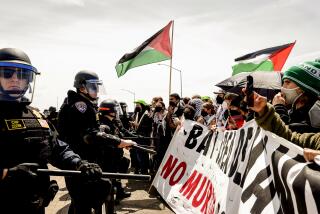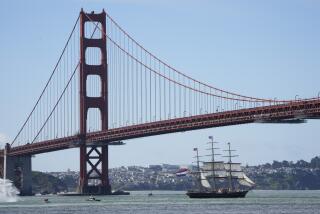Portland protesters hanging from bridge disrupt Arctic-bound Shell vessel

Greenpeace activists hang from the St. Johns Bridge in Portland Ore., to block a Shell vessel that will assist in Arctic oil drilling operations. Law enforcement authorities eventually cleared the protesters, and the vessel headed for the Pacific Ocean.
- Share via
Reporting from Seattle — Royal Dutch Shell’s narrow summer window to drill for oil in the Arctic became slightly narrower Thursday after protesters in Portland, Ore., suspended themselves from one of the city’s many famous bridges to briefly block an essential support vessel from traveling north.
Hanging over the Willamette River from rock-climbing ropes, 13 protesters from Greenpeace had already spent more than 24 hours in suspension when the Shell ship, the icebreaker MSV Fennica, escorted by local law enforcement vessels and the Coast Guard, began making its way toward them after 6 a.m. Thursday.
But as the Fennica moved closer, the airborne protesters, joined by kayakers below, held their airspace, and the Fennica turned around and went back to its dock.
It was a short-lived victory, however.
Less than 12 hours later, law enforcement officers rappelled down to remove three protesters and jumped into the water to clear kayakers, several of whom jumped or were knocked out of their kayaks into the water. In a hectic scene carried live on local television, the Fennica wove through a narrow opening between suspended protesters, passed under the bridge and began making its way to the Pacific Ocean.
“Everybody is feeling pretty emotional at the moment,” said Cassady Sharp, a spokeswoman for Greenpeace USA. “That seemed like a really dangerous thing for the Coast Guard to let happen.”
Authorities said the protesters were the ones acting dangerously.
The climbers first descended from the deck of the St. Johns Bridge about 2 a.m. Wednesday. Their initial encounters with law enforcement were relatively calm. On Thursday morning, authorities told the protesters they were trespassing and violating a Coast Guard safety zone.
“But we didn’t go anywhere and the police didn’t do anything,” Sharp said.
The climbers had supplies to stay for “several days” and were receiving fresh supplies from protesters on the bridge above them, she said. Some had platforms on which to rest, while others had hammock-like supports. Sharp said the heat could become a factor — the temperature reached 103 Thursday afternoon.
A federal court ruling in Alaska on Thursday also put pressure on the protesters. The judge found that the protest violated an injunction imposed after Greenpeace’s boarding of a Shell vessel in April.
The judge’s finding, which came in response to a complaint Shell filed Wednesday, required Greenpeace to pay $2,500 for each hour it continued its Portland protest.
“We have consistently stated that we respect the right of individuals to protest our Arctic operations so long as they do so safely and within the boundaries of the law,” Curtis Smith, a spokesman for Shell, said in an email Thursday. “The staging of protesters in Portland was not safe nor was it lawful.”
The Fennica is already supposed to be at Shell’s exploratory drilling site in the Arctic’s Chukchi Sea, but it was sent to Portland this month for repairs to its damaged hull.
The ship, one of two icebreakers Shell must have on site, carries equipment that is also essential to the oil giant’s plan to install a capping stack used to help contain a potential spill.
Last week, the Obama administration gave Shell final permission to drill in the Chukchi Sea but said the company could drill only top holes — not drill into oil-bearing zones — until the capping stack is in position to respond to a potential spill within 24 hours. Shell must complete its operations by late September.
About the same time the Fennica cleared the St. Johns Bridge, Shell began preliminary drilling in the Chukchi.
“In the days ahead, the team aboard the rig will work to complete the top portion of the Burger J well in anticipation of drilling to total depth once the Fennica arrives on site,” Smith said in an email. “We remain committed to operating safely and responsibly and adding to Shell’s long history of exploration offshore Alaska.”
The St. Johns Bridge afforded protesters an advantageous place to take a stand. Built in 1931, it is a little more than 200 feet above the river.
In May, protesters in Seattle tried but failed to block a Shell drilling rig from docking in Elliott Bay. They tried and failed to block it again in June when the rig left for the Arctic. But Elliott Bay is a much bigger body of water than the Willamette, and Shell did not have to guide its rig under a bridge.
The new setting provided Greenpeace with a new tactic.
Portland and Seattle are rivals in many matters, including in their capacity for liberal activism. Portland’s protest took cues from Seattle. In 1997, eight Greenpeace volunteers were arrested after they spent two days suspended from a bridge over Seattle’s Lake Washington Ship Canal, across which they had stretched a 400-foot net to try to prevent a large fishing trawler from leaving for Alaska.
ALSO:
Contaminated cooling towers studied in South Bronx Legionnaires’ disease outbreak
Congress approves stopgap bill to keep highway projects going
GOP candidates to visit Southern California for Koch brothers event
More to Read
Sign up for Essential California
The most important California stories and recommendations in your inbox every morning.
You may occasionally receive promotional content from the Los Angeles Times.











